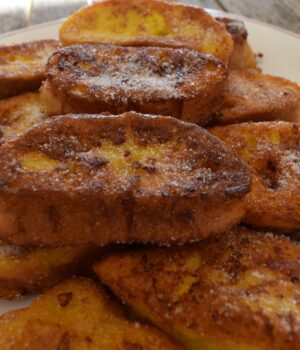Torrijas are a treasure of our gastronomic tradition and Mediterranean cuisine. They are especially popular during Holy Week in countries like Spain. These delicacies, simple in appearance but extraordinary in taste, have a history that goes back centuries.
The origin of torrijas lies in the need to use leftover bread. In the Middle Ages, stale bread soaked in milk or wine was used to make an inexpensive and nutritious dish. Over time, this recipe evolved, acquiring different variations and refinements.
The basic recipe for torrijas involves soaking slices of bread in a mixture of milk, egg and sugar, then frying them in hot oil. Then they are sprinkled with honey or sugar and cinnamon. However, there are many regional and personal versions of this dish, using ingredients such as wine, syrup, or even adding fillings such as pastry cream or fruit.
Torrijas, culture and use
In addition to being a pleasure for the palate, torrijas also have significant cultural and symbolic value. During Lent, a period of fasting and abstinence, the French toasts They offered a momentary indulgence before the arrival of Easter. Their association with Holy Week makes them an indispensable element of religious and family celebrations.
From a nutritional point of view, torrijas can be considered an occasional treat due to their calorie content and fried preparation method. However, its main ingredient, bread, provides carbohydrates and energy, while milk and eggs provide protein and other essential nutrients.
Despite their simplicity, torrijas continue to be a symbol rooted in Mediterranean culinary culture, passed down from generation to generation. Its sweet and comforting aroma, its soft texture on the inside and crunchy on the outside, make each bite an unforgettable experience.
In short, torrijas are not simply a dessert, they are a piece of history, tradition and flavor. A perfect excuse that unites people around the table, celebrating the joy and sweetness of life.







